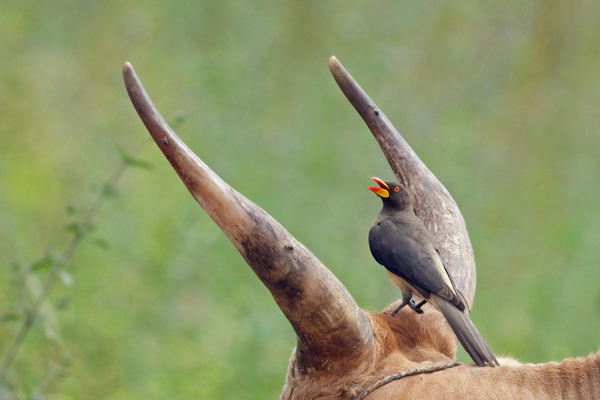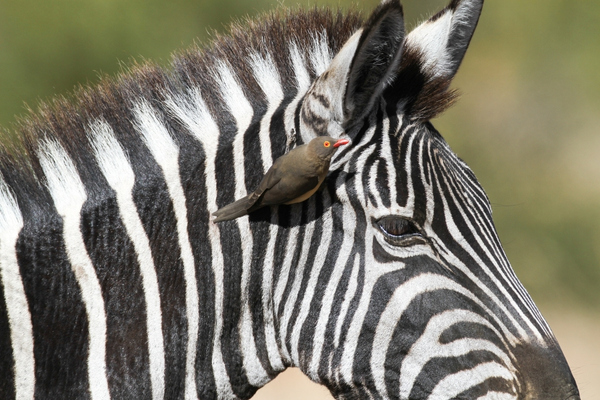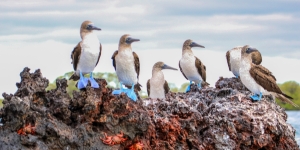The two oxpeckers - helpfully named Red-billed and Yellow-billed - live throughout sub-Saharan Africa, where they are easily encountered aboard nearly any animal bigger than a golden retriever. They are handsome birds, clad in smooth clay-brown with brilliant beaks and eyes in different combinations of red and yellow. They’re hard to miss as they climb nimbly over their hosts, even as the larger animals move about.

Yellow-billed Oxpecker on an Ox in The Gambia (Photo credit: Justin Peter)

Red-billed Oxpecker on Plains Zebra in Uganda
At first glance, the relationship between an oxpecker and its ride seems like a perfect example of mutualism: a relationship where both animals benefit. The oxpecker takes advantage of a buffet of ticks, mites, and other parasites while the rhinoceros or zebra enjoys the removal of said parasites. Food is good and removing parasites is good, so everybody wins.
This wholesome understanding of the oxpecker-mammal relationship was long thought complete, but in recent years there has been growing evidence that all may not be as it seems. It is indeed true that oxpeckers eat parasites like ticks, but studies have shown that the presence of oxpeckers doesn’t actually reduce the number of ticks on a large animal. It appears that these enterprising birds may focus most of their feeding time on wounds.
It has long been observed that oxpeckers clean wounds on the skin of their hosts, eating insects that infest the exposed flesh. It has more recently been shown that oxpeckers drink blood from these wounds too. With wounds providing such a rich source of food for the oxpeckers, it should really come as no surprise that they also peck at them to prevent healing or expand them, and even create new wounds from scratch.
These revelations really move the oxpecker from helpful parasite remover to parasite itself. The relationship is beneficial to the bird, sure, but any benefit to the mammal in terms of parasite removal is surely offset by the detriment of blood drinking and wound creation. Given the choice, you’d have to think most mammals would opt out of this avian cleaning service.
Unfortunately opting out is not an option for the big, lumbering beasts of the savannah. Elephants and rhinos are slow and inflexible, while oxpeckers are agile, fast and persistent. Host animals may occasionally attempt to remove the bothering birds, but most eventually accept that there’s little to be done and simply allow them to go about their business.
In the light of discovery, the oxpeckers’ relationships may seem harsh or even cruel, but nature is full of innovative solutions to challenging problems. In the hot, dry African savannah the oxpeckers have found a generous and renewable source of food and hydration, untapped and freely available. By taking advantage they are able to survive in this difficult habitat, feed their young, and secure the future of their species.
If you are fortunate enough to see them, this new knowledge makes oxpeckers even more fascinating to observe. You can watch birds eat insects on your front lawn, but the opportunity to see blood-drinking birds at work is rare and special. This unusual behaviour may be shared by only one other bird in the world: the aptly-named Vampire Ground-Finch of the Galapagos.
The oxpeckers are a testament to the fact that relationships in nature are often more complicated than they appear. They also show us that our first assumptions are often wrong, and there’s always more to learn in the natural world. If you’ve got a trip to Africa on the horizon, be sure to put the oxpeckers on your must-see list. They’re beautiful, resourceful, and just a little macabre. What more could you ask for?
Be on the lookout for Oxpeckers on the following Quest Nature Tours in sub-Saharan Africa:
The Gambia | November 7 – 18, 2025
Zambia: Insider’s Africa | November 3 – 14, 2025
Great Apes and Wildlife of Uganda | December 9 – 18, 2025
Tanzania Classic Safari: The Great Migration | February 18 – March 1, 2026


